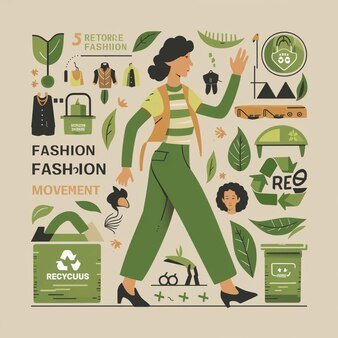As we move into 2024, the fashion industry is undergoing a significant transformation. People are becoming more aware of the environmental impact of their clothing choices, leading to a rise in sustainable fashion. This approach focuses on eco-friendly practices, ethical brands, and mindful consumption, making it easier than ever to dress in a way that respects our planet. Here’s how you can embrace eco-friendly clothing and adopt a sustainable wardrobe this year.
1. Understand Sustainable Fashion
Sustainable fashion is not just a trend; it’s a movement aimed at reducing the negative impact of clothing on the environment and society. It encompasses various practices, including using organic materials, reducing waste, and ensuring fair labor conditions. In 2024, it’s essential to understand that our clothing choices can either contribute to the problem or help create solutions.
2. Choose Eco-Friendly Clothing
When shopping for clothes, look for eco-friendly clothing options. These garments are made from sustainable materials, such as organic cotton, linen, hemp, or recycled fabrics. Here are some tips for finding eco-friendly pieces:
- Research materials: Understand the differences between materials. For instance, organic cotton uses fewer chemicals compared to conventional cotton. Similarly, Tencel, made from wood pulp, is biodegradable and has a lower environmental footprint.
- Check certifications: Look for labels and certifications like GOTS (Global Organic Textile Standard), OEKO-TEX, or Fair Trade. These ensure that the clothing meets specific environmental and ethical standards.
- Opt for local brands: Supporting local designers and manufacturers can reduce the carbon footprint associated with shipping and promote community-based economies.
3. Support Ethical Brands
In 2024, many ethical brands are dedicated to sustainable practices. These brands prioritize fair labor conditions, environmental stewardship, and transparency in their supply chains. Here’s how to identify and support ethical brands:
- Do your research: Investigate brands’ values and practices. Websites like Good On You provide ratings and reviews of brands based on their sustainability and ethical practices.
- Read about their story: Many ethical brands share their mission and production methods on their websites. Look for brands that are transparent about their sourcing and labor practices.
- Prioritize longevity: Choose brands that focus on creating durable, timeless pieces rather than fast fashion. This aligns with the concept of slow fashion, which encourages quality over quantity.
4. Embrace Slow Fashion
Slow fashion is a movement that promotes thoughtful consumption. It encourages people to buy fewer items but invest in quality pieces that last longer. Here are some ways to embrace slow fashion:
- Invest in versatile basics: Choose timeless pieces that can be mixed and matched easily. A well-fitted pair of jeans, a classic white shirt, and a versatile jacket can create countless outfits.
- Shop secondhand: Thrift stores, consignment shops, and online platforms like Depop or Poshmark offer a treasure trove of unique, pre-loved items. This not only reduces waste but also gives clothing a new life.
- Host clothing swaps: Organize a clothing swap with friends or family. It’s a fun way to refresh your wardrobe without spending money or contributing to textile waste.
5. Make Your Wardrobe More Eco-Friendly
Transforming your wardrobe into an eco-friendly haven requires some effort, but the results are rewarding. Here’s how you can make your clothing collection more sustainable:
- Declutter mindfully: When cleaning out your wardrobe, donate or sell items you no longer wear. Ensure they are in good condition so they can be reused by others.
- Care for your clothes: Proper care can extend the life of your garments. Follow washing instructions, avoid excessive drying, and repair items instead of throwing them away. Learning basic sewing skills can be incredibly useful.
- Create a capsule wardrobe: A capsule wardrobe consists of a limited number of versatile pieces that can be mixed and matched. This not only simplifies your daily outfit choices but also reduces the urge to buy more.
6. Incorporate Green Living into Your Style
Living sustainably goes beyond just clothing; it’s a lifestyle choice. To further enhance your eco-friendly fashion journey, consider these green living practices:
- Choose sustainable accessories: Look for bags, shoes, and jewelry made from sustainable materials or ethical brands. Items made from recycled materials can also be great options.
- Support sustainable initiatives: Participate in or donate to organizations focused on environmental conservation and sustainable fashion. Many brands also support various causes, so check if your favorite brand gives back.
- Stay informed: Follow sustainable fashion blogs, influencers, and organizations to stay updated on trends and practices in the eco-friendly fashion world. Knowledge is power, and being informed can help you make better choices.
7. The Future of Sustainable Fashion
As the fashion industry continues to evolve, the push for sustainability will only grow stronger. In 2024, consumers are demanding more transparency and responsibility from brands. By prioritizing sustainable fashion, we can collectively create a more ethical and eco-friendly industry.
Conclusion
Dressing in a sustainable manner in 2024 is not only possible but also enjoyable. By embracing eco-friendly clothing, supporting ethical brands, and practicing slow fashion, you can make a positive impact on the environment while expressing your personal style. Remember that every small change contributes to a larger movement towards green living. With a mindful approach to your wardrobe, you can dress stylishly while respecting our planet and its resources. So, let’s commit to sustainable fashion and inspire others to do the same!





